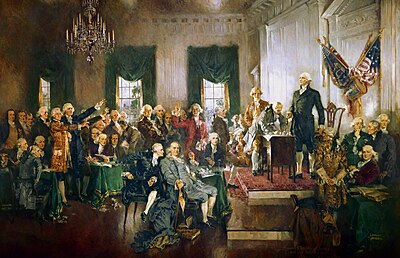
Oil painting is the process of painting with pigments with a medium of drying oil as the binder. It has been the most common technique for artistic painting on canvas, wood panel or copper for several centuries, spreading from Europe to the rest of the world. The advantages of oil for painting images include "greater flexibility, richer and denser colour, the use of layers, and a wider range from light to dark". But the process is slower, especially when one layer of paint needs to be allowed to dry before another is applied.

The Maryland State House is located in Annapolis, Maryland. It is the oldest U.S. state capitol in continuous legislative use, dating to 1772 and houses the Maryland General Assembly, plus the offices of the Governor and Lieutenant Governor. In 1783 and 1784 it served as the capitol building of the United States Congress of the Confederation, and is where Ratification Day, the formal end of the American Revolutionary War, occurred.

Gunning Bedford Jr. was an American Founding Father, delegate to the Congress of the Confederation, Attorney General of Delaware, a delegate to the Constitutional Convention in 1787 which drafted the United States Constitution, a signer of the United States Constitution, and a United States district judge of the United States District Court for the District of Delaware.

Richard Bassett was an American politician, attorney, slave owner and later abolitionist, veteran of the American Revolution, signer of the United States Constitution, and one of the Founding Fathers of America. He also served as United States Senator from Delaware, chief justice of the Delaware Court of Common Pleas, governor of Delaware and a United States circuit judge of the United States Circuit Court for the Third Circuit.

Daniel Carroll was an American politician and plantation owner from Maryland and one of the Founding Fathers of the United States. He supported the American Revolution, served in the Confederation Congress, was a delegate to the Philadelphia Convention of 1787 which penned the Constitution of the United States, and was a U.S. Representative in the First Congress. Carroll was one of five men to sign both the Articles of Confederation and the Constitution. He was one of the few Roman Catholics among the Founders.

Howard Chandler Christy was an American artist and illustrator. Famous for the "Christy Girl" – a colorful and illustrious successor to the "Gibson Girl" – Christy is also widely known for his iconic WWI military recruitment and Liberty loan posters, along with his 1940 masterpiece titled, Scene at the Signing of the Constitution of the United States, which is installed along the east stairwell of the United States Capitol.
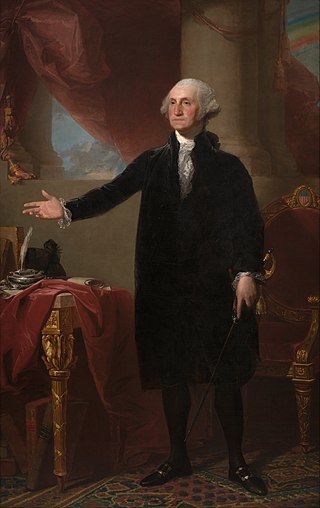
The Lansdowne portrait is an iconic life-size portrait of George Washington painted by Gilbert Stuart in 1796. It depicts the 64-year-old president of the United States during his final year in office. The portrait was a gift to former British Prime Minister William Petty, 1st Marquess of Lansdowne, and spent more than 170 years in England.

Declaration of Independence is a 12-by-18-foot oil-on-canvas painting by the American artist John Trumbull depicting the presentation of the draft of the Declaration of Independence to Congress. It was based on a much smaller version of the same scene, presently held by the Yale University Art Gallery. Trumbull painted many of the figures in the picture from life, and visited Independence Hall to depict the chamber where the Second Continental Congress met. The oil-on-canvas work was commissioned in 1817, purchased in 1819, and placed in the United States Capitol rotunda in 1826.

The Brumidi Corridors are the vaulted, ornately decorated corridors on the first floor of the Senate wing in the United States Capitol.
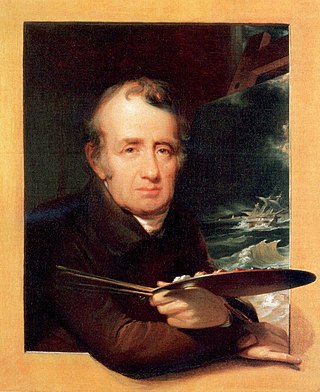
Thomas Birch was an English-born American portrait and marine painter.
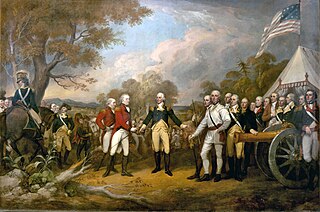
The Surrender of General Burgoyne is an oil painting by the American artist John Trumbull. The painting was completed in 1821 and hangs in the United States Capitol rotunda in Washington, D.C.

The Surrender of Lord Cornwallis is an oil painting by John Trumbull. The painting, which was completed in 1820, now hangs in the rotunda of the United States Capitol in Washington, D.C.
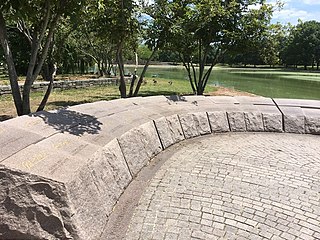
The Memorial to the 56 Signers of the Declaration of Independence is a memorial depicting the signatures of the 56 signatories to the United States Declaration of Independence. It is located in the Constitution Gardens on the National Mall in Washington, D.C. The memorial is accessible to the public by crossing a wooden bridge onto a small island set in the lake between Constitution Avenue and the Reflecting Pool, not far from the Vietnam Veterans Memorial.
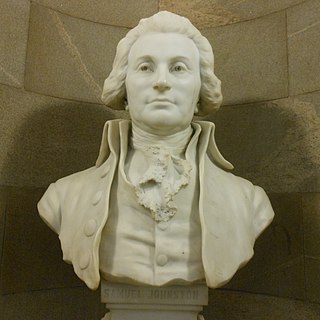
The Hillsborough Convention, was the first of two North Carolina conventions to ratify the United States Constitution. Delegates represented 7 boroughs and 59 counties, including six western counties that became part of Tennessee when it was created in 1796. They met in Hillsborough, North Carolina from July 21 to August 4, 1788 to deliberate and determine whether to ratify the Constitution recommended to the states by the General Convention that had been held in Philadelphia the previous summer. The delegates had won their seats through special elections held in March 1788, as mandated by the North Carolina General Assembly. Governor Samuel Johnston presided over the Convention. The Hillsborough Convention was dominated by anti-Federalists, and North Carolina did not ratify the Constitution until the Fayetteville Convention, which met a year later.

The conservation and restoration of paintings is carried out by professional painting conservators. Paintings cover a wide range of various mediums, materials, and their supports. Painting types include fine art to decorative and functional objects spanning from acrylics, frescoes, and oil paint on various surfaces, egg tempera on panels and canvas, lacquer painting, water color and more. Knowing the materials of any given painting and its support allows for the proper restoration and conservation practices. All components of a painting will react to its environment differently, and impact the artwork as a whole. These material components along with collections care will determine the longevity of a painting. The first steps to conservation and restoration is preventive conservation followed by active restoration with the artist's intent in mind.

The Signing of the United States Constitution occurred on September 17, 1787, at Independence Hall in Philadelphia, Pennsylvania, when 39 delegates to the Constitutional Convention, representing 12 states, endorsed the Constitution created during the four-month-long convention. In addition to signatures, this endorsement, the Constitution's closing protocol, included a brief declaration that the delegates' work has been successfully completed and that those whose signatures appear on it subscribe to the final document. Included are, a statement pronouncing the document's adoption by the states present, a formulaic dating of its adoption, along with the signatures of those endorsing it. Additionally, the convention's secretary, William Jackson, added a note to verify four amendments made by hand to the final document, and signed the note to authenticate its validity.

Washington Crossing the Delaware is the title of three 1851 oil-on-canvas paintings by the German-American artist Emanuel Leutze.

Diana, Princess of Wales is a 1981 painting of Diana, Princess of Wales, by the British artist Bryan Organ. It was commissioned by the National Portrait Gallery in London following Diana's engagement to Charles, Prince of Wales, in February 1981 while the gallery was under the directorship of John Hayes. It presently hangs as part of the National Portrait Gallery's permanent collection.

The Fayetteville Convention was a meeting by 271 delegates from North Carolina to ratify the US Constitution. Governor Samuel Johnston presided over the convention, which met in Fayetteville, North Carolina, from November 16 to 23, 1789 to debate on and decide on the ratification of the Constitution, which had recommended to the states by the Philadelphia Convention during the summer of 1787. The delegates ratified the Constitution by a vote of 194 to 77, thus making North Carolina the 12th state to ratify the constitution.

The Passage of the Delaware is a large, Neoclassical 1819 oil-on-canvas painting by Thomas Sully. With attention to historical accuracy, the painting depicts George Washington on horseback observing the troops of the American Revolutionary Army in the process of crossing the Delaware River prior to the surprise attack on Hessian troops on December 26, 1776, at the Battle of Trenton. The image is intended to capture the moment prior to George Washington dismounting his horse and joining his army in crossing the Delaware River.
